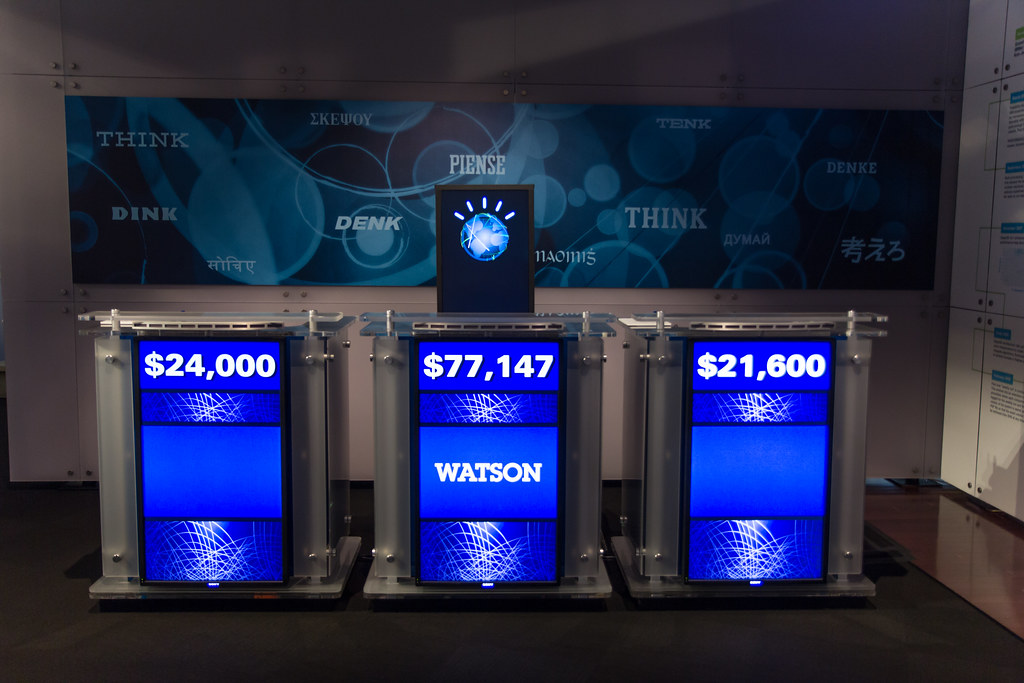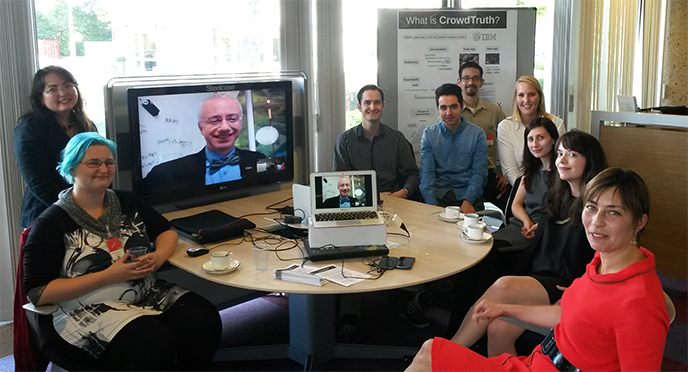 Watson achieved noteriety when it won Jeaopardy a few years back. Image via Atomic Taco
Watson achieved noteriety when it won Jeaopardy a few years back. Image via Atomic Taco
What’s next for data enrichment and Watson?
Lora Aroyo from VU University Amsterdam, Chris Welty from the IBM Watson Research Center and Robert-Jan Sips of IBM Netherlands are leading the charge with CrowdTruth. Their work focuses on the labeling of training data that combines both subject matter experts and crowd contributors to strengthen Watson’s machine learning algorithms. What they’ve discovered is groundbreaking. The CrowdTruth Team
CrowdTruth has found that expert annotators, highly paid health professionals working on training data creation, agree only 30% of the time. While the “popular crowd vote” covers 95% of expert agreement. Why? Experts don’t pay close attention to granularity in linguistic expression. Crowd contributors do. What this means, is that the collective intelligence of an unbiased crowd is as good, if not better, than expensive experts sitting in a room. The diversity of their annotations help Watson understand the details that expert trainers gloss over.
I recently spoke with Lora Aroyo, who summarized CrowdTruth’s approach to training data creation:
“The crowd of anonymous workers, typically unbiased from possible domain expertise, is processing text examples from a pure linguistic perspective, and in this way captures the diversity of interpretations provided by expert annotators.”
In years past, the only path to clean training data was a laborious grant process and onboarding an army of contractors which was costly, time consuming and far from scalable. But today, researchers can simply switch Appen’s massive, on-demand workforce on-and-off to structure and extract knowledge from vast quantities of medical texts, images and videos. So much so, that CrowdTruth is proving that these layman data labelers are more effective at interpreting semantic content than paid professionals. The reason being, is that experts interpret data with pre-formed biases. Wheras crowd contributors, especially if you’re asking a bunch of them per data point, as CrowdTruth is, interpret data in a way that accounts for the spectrum of possible interpretations. Thus, Watson ingests a broader and more reliable vector to draw from as it computes predicitons.
CrowdTruth’s training data complements medical expert inputs with the primary purpose of extracting insights from medical documents. By introducing people-powered data enrichment into Watson’s machine learning workflow, the system can supplement the need for expert trainers and more rapidly extract crucial knowledge from the likes of Wikipedia articles, patient case reports and beyond.
The CrowdTruth Team
CrowdTruth has found that expert annotators, highly paid health professionals working on training data creation, agree only 30% of the time. While the “popular crowd vote” covers 95% of expert agreement. Why? Experts don’t pay close attention to granularity in linguistic expression. Crowd contributors do. What this means, is that the collective intelligence of an unbiased crowd is as good, if not better, than expensive experts sitting in a room. The diversity of their annotations help Watson understand the details that expert trainers gloss over.
I recently spoke with Lora Aroyo, who summarized CrowdTruth’s approach to training data creation:
“The crowd of anonymous workers, typically unbiased from possible domain expertise, is processing text examples from a pure linguistic perspective, and in this way captures the diversity of interpretations provided by expert annotators.”
In years past, the only path to clean training data was a laborious grant process and onboarding an army of contractors which was costly, time consuming and far from scalable. But today, researchers can simply switch Appen’s massive, on-demand workforce on-and-off to structure and extract knowledge from vast quantities of medical texts, images and videos. So much so, that CrowdTruth is proving that these layman data labelers are more effective at interpreting semantic content than paid professionals. The reason being, is that experts interpret data with pre-formed biases. Wheras crowd contributors, especially if you’re asking a bunch of them per data point, as CrowdTruth is, interpret data in a way that accounts for the spectrum of possible interpretations. Thus, Watson ingests a broader and more reliable vector to draw from as it computes predicitons.
CrowdTruth’s training data complements medical expert inputs with the primary purpose of extracting insights from medical documents. By introducing people-powered data enrichment into Watson’s machine learning workflow, the system can supplement the need for expert trainers and more rapidly extract crucial knowledge from the likes of Wikipedia articles, patient case reports and beyond.











